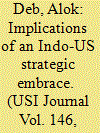| Srl | Item |
| 1 |
ID:
146953


|
|
|
| 2 |
ID:
185777


|
|
|
|
|
| Summary/Abstract |
The physical map of the Indian subcontinent depicts an integrated landmass, bounded by the Pamirs/ Hindukush to the North West and the Himalayas to the North, with the Patkai Range, Naga, and Chin Hills forming a natural border between India’s North-Eastern states and Myanmar. The ends of the Indian Peninsula are bounded by the seas in three directions. This article attempts to review important aspects of the continuously evolving India-Bangladesh relationship—as Bangladesh, today with the second largest GDP in South Asia, journeys through its fifty-first year as an independent nation.
|
|
|
|
|
|
|
|
|
|
|
|
|
|
|
|
| 3 |
ID:
169477


|
|
|
|
|
| Summary/Abstract |
With the melting of snow and improvement in weather conditions, the Line of Control (LoC) in Jammu and Kashmir (J&K) that separates India and Pakistan has traditionally been a ‘hot’ place in summers, with multiple ceasefire violations by Pakistan culminating in frequent artillery duels. Over time, and well before the era of instant news, this perception of the LoC had embedded itself in the collective consciousness of the Indian public. Despite loss of life and property in the border areas and continued suffering of the local residents throughout the 1990s, the possibility of an all-out war over Kashmir had veered from the probable to the unlikely, more so after then Prime Minister Atal Bihari Vajpayee’s famous bus ride to Lahore in January 1999. Also, given the traditional tranquillity prevailing in the border districts of Kargil and Leh, the possibility of a full-fledged war in Ladakh was considered to be even more remote. All these suppositions came crashing down in the summer of 1999 after discovery of the intrusions in the Dras, Kargil and Batalik sectors, leading to the initiation of full-fledged combat operations by the Indian Armed Forces.
|
|
|
|
|
|
|
|
|
|
|
|
|
|
|
|